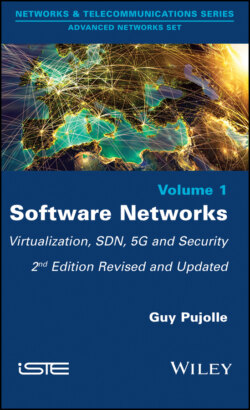Читать книгу Software Networks - Guy Pujolle - Страница 18
1.2. Hypervisors and containers
ОглавлениеClearly, virtualization needs hardware, which can be standard. We speak of commodity hardware (white box), with open specifications, produced en masse to achieve particularly low prices. We will talk further about it in the chapter on open source software (Chapter 4). There are various ways of placing virtual machines on physical equipment, and they can be classified into three broad categories, as shown in Figures 1.4–1.6. The first two figures correspond to hypervisors and the third figure corresponds to containers.
Figure 1.4. Paravirtualization. For a color version of the figure, see www.iste.co.uk/pujolle/software2.zip
A paravirtualization hypervisor is a program that is directly executed on a hardware platform and which hosts virtual machines linked to operating systems that have been modified so that the virtual machines’ instructions are directly executed on a hardware platform. This platform is able to support guest operating systems with their drivers. The classic hypervisors in this category include Citrix Xen Server (open source), VMware vSphere, VMware ESX, Microsoft Hyper-V Server, Bare Metal and KVM (open source). These programs are also known as type-1 hypervisors.
The second category of hypervisor, or type 2 hypervisor, is a program that is executed on the hardware platform, supporting native operating systems, which means without any modification. The native operating system, when invited by the hypervisor, is executed on the device thanks to an emulator so that the underlying device takes all constructions into account. The guest operating systems are unaware that they are virtualized, so they do not require any modifications, as opposed to paravirtualization. Examples of this type of virtualization would include Microsoft Virtual PC, Microsoft Virtual Server, Parallels Desktop, Parallels Server, Oracle VM Virtual Box (free), VMware Fusion, VMware Player, VMware Server, VMware Workstation and QEMU (open source).
Figure 1.5. Virtualization by emulation. For a color version of the figure, see www.iste.co.uk/pujolle/software2.zip
The third type leaves behind the previous hypervisor systems, running several machines simultaneously as containers. In such case, we speak of an isolator. An isolator is a program that isolates the execution of the applications in an environment, called the context, or indeed the zones of execution. Thus, the isolator is able to run the same application multiple times in a multi-instance mode. This solution performs very well, because it does not cause any overload, but the environments are more difficult to isolate.
Figure 1.6. Virtualization by containers. For a color version of the figure, see www.iste.co.uk/pujolle/software2.zip
In summary, this last solution facilitates the execution of the applications in execution zones. In this category, we can cite the examples of Linux-Vserver, chroot, BSD Jail and Open VZ and most of the container solutions such as Docker.
